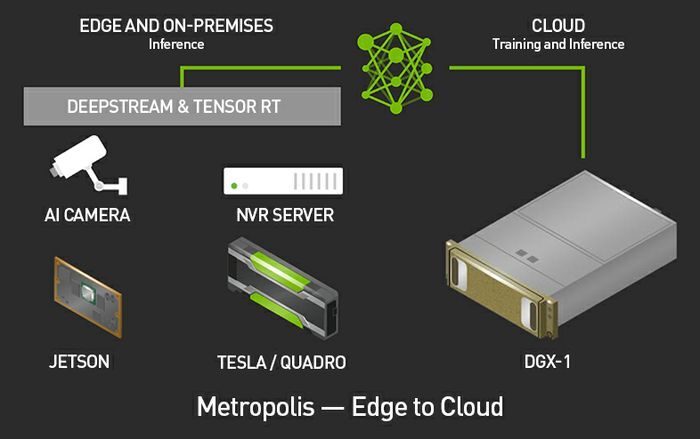Nvidia has a vision for the city of the future, and it takes the always-on surveillance we're becoming accustomed to and pushes it to whole new levels. The company's Metropolis intelligent video analytics platform applies deep learning to constantly process and contextualize the masses of data streaming from the ever-increasing number of cameras watching us every day.
It's one thing to have cameras watching at all times, but another altogether to do something useful with the giant stack of data they're producing day and night. Manpower costs make sitting and watching it all unfeasible, but computers taking advantage of machine learning and artificial intelligence could. And this perfectly lines up with the new direction Nvidia has been pushing in for the last few years.
No longer just a graphics card manufacturer aiming to push more pixels in the latest first person shooter, Nvidia's video processing and machine learning chips are starting to become benchmarks in a number of growing industries. For example, in industrial drones they're helping to automatically recognize and track assets on large work sites, and in self-driving cars they're taking a "watch and learn" approach to figuring out how traffic works.
Now Nvidia believes there's an opportunity to use AI, deep learning and a gushing firehose of data to monitor and optimize the entire organism of a city. And it's working toward that goal with Metropolis. This platform encompasses a number of Nvidia products all operating on a unified architecture, which can come together to analyze and make sense of video in real time.

Through partner businesses, Nvidia's technology is set to take things even further, enabling autonomous aerial systems streaming video back from the sky, security robots driving themselves around looking for trouble spots, and ultra high resolution, super-wide panoramic cameras that capture a whole scene instead of needing to track and follow objects.
And instead of just recording and storing footage, every camera's output would be constantly analyzed and crunched into useful data points. We're talking facial recognition, vehicle recognition, and pattern tracking in road and pedestrian traffic.
Clearly this will be useful in a law enforcement and security sense, and several Nvidia partners are working along these lines. BriefCam, for example, is demonstrating technology that tracks individuals and vehicles through security footage, then produces super-quick review videos in which all events in a given time frame can be made to happen in a condensed format where a bunch of them are on screen at once.
It's a smart system, too. You can ask it to show you a condensed video montage of just the red cars that came down a given street, or just the bicycles that turned right at a given intersection within a given time period. It's extraordinary to watch and a huge time-saver, and it does a good job highlighting unusual behaviours.
But the real power of the broader Metropolis system is in pattern and behaviour analysis, and when it gets the ability to make decisions that impact those behaviours. For example, intersections that can read traffic flows and adjust their traffic light patterns accordingly, camera systems that can automatically flag irregular events and put them in front of human operators for immediate action, or intelligent car parks that can funnel traffic toward the most efficient spots to keep the whole system running smoothly.
It's an opportunity to make all kinds of things run better. Knowing capitalism, it will probably also result in supermarket layouts that route you past the maximum number of impulse purchase snack displays, and become part of the face-detection personal advertising onslaught we've been expecting for decades now.
And it's all built on top of image processing technologies coming out of a company that got its start in video game graphics. Nvidia's pivot into deep learning and artificial intelligence, as well as extremely strong performance out of its core gaming products, has seen its previously stable share price triple in value in the last 12 months.
Nvidia is expecting there to be a billion cameras out there by 2020, and by taking on the challenge of working out exactly how to deal with that giant deluge of data it's identified a huge need.
Nvidia presented its Metropolis intelligent video analytics platform, along with some 20-odd demos of its partner applications, at last month's International Security Conference and Expo in Las Vegas.
Just some of the applications for the technology can be seen in the video below.
Source: Nvidia







